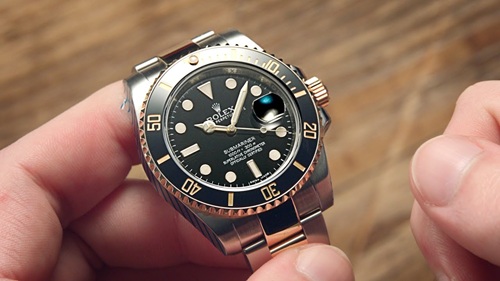Rolex is one of the most prestigious watch brands in the world. Known for luxury, precision, and timeless design, a Rolex is more than just a watch—it is a status symbol. Because of its global popularity, counterfeit Rolex watches are also widely available in the market. Many fakes look almost identical to the original, making it difficult for the average buyer to differentiate between them. However, by paying attention to specific details, one can identify whether a Rolex is real or fake.
In this article, we’ll discuss the key signs that help in identifying a genuine Rolex watch.

Check the Weight
A real Rolex is made with premium-quality metals like stainless steel, gold, or platinum. These materials make the watch heavier than fake ones, which are usually made of cheap alloys. When you hold a Rolex, it should feel solid and weighty, not light or flimsy.
Examine the Movement
Rolex watches are known for their smooth second-hand movement. While many counterfeits try to copy this, they often fail.
- Original Rolex: The second hand sweeps smoothly without noticeable ticks.
- Fake Rolex: The second hand may “tick” once per second or move unevenly.
Rolex uses high-precision automatic mechanical movements, and the smoothness is one of its strongest identifiers.
Inspect the Cyclops Lens
Most Rolex models with a date display have a small magnifying glass called the Cyclops lens.
- Genuine Rolex: The lens magnifies the date by 2.5 times, making the numbers appear larger and easy to read.
- Fake Rolex: The magnification is weak or absent, and the date may look small or distorted.
Look for the Crown Logo
Rolex places a tiny crown logo (its iconic symbol) at the 12 o’clock position on the dial. In modern models, there is also a micro-etched crown at the 6 o’clock position on the sapphire crystal, visible only under magnification. Fake watches often miss this fine detail.
Serial and Model Numbers
Every Rolex watch has a unique serial number and model number engraved between the lugs (the part of the case where the strap connects).
- Original Rolex: The engraving is sharp, deep, and precise.
- Fake Rolex: Numbers may appear shallow, poorly aligned, or printed instead of engraved.
These numbers can also be cross-verified with official Rolex databases or authorized dealers.
Case Back
Most Rolex watches have a smooth metal case back without any engravings or designs. Exceptions include some vintage or special models. If you see a Rolex with a clear case back showing the movement, it is most likely a fake.
Sound Test
Rolex movements are extremely quiet.
- Real Rolex: Almost silent ticking due to high-quality engineering.
- Fake Rolex: Louder ticking sound, as cheaper quartz movements are often used.
Price and Source
If a deal sounds too good to be true, it probably is. A new Rolex usually costs several lakhs of rupees (or thousands of dollars). Be cautious of online sellers or unknown dealers offering Rolex watches at heavy discounts. Always buy from authorized Rolex retailers or trusted jewelers.
Dial and Detailing
The finishing on a genuine Rolex is flawless:
- The fonts are crisp and evenly spaced.
- The hour markers are perfectly aligned.
- The hands move smoothly without any roughness.
- Fake watches often show spelling errors, uneven fonts, or sloppy detailing.
Conclusion
Identifying a real Rolex requires careful observation of details like weight, movement, engravings, and overall craftsmanship. Counterfeiters may try to replicate the design, but they cannot match the precision, durability, and fine detailing of a genuine Rolex. If you are planning to buy one, always purchase from authorized dealers, check the serial number, and pay close attention to the unique features. Remember, a real Rolex is not just a luxury—it is an investment that lasts for generations.